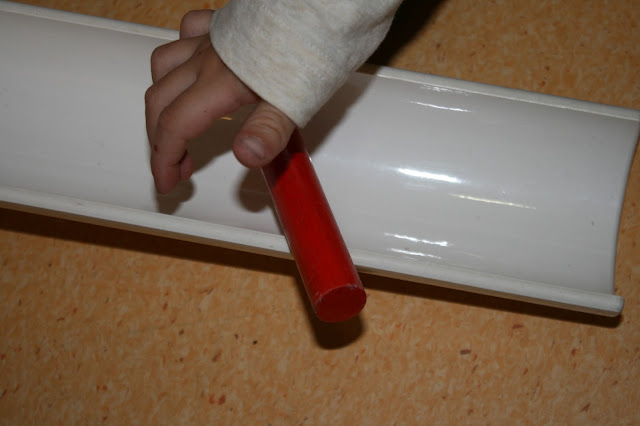Okay... Friday was officially a FANTASTIC day researching alongside the toddlers. The teachers and I had talked a few weeks prior about the number of balls and ramps available in the classroom. We decided to set up a ramp provocation in the mini atelier just outside their door. It didn't take long before the toddlers became interested in the activity in a BIG way. They began rolling the small yellow balls provided, but soon gathered materials from their classrooms to roll down the ramps.
Other teachers became curious and offered possibilities to try.
In a very short time we had a full fledged research lab where the children investigated: friction, gravity, simple machines and acceleration using ramps and objects. Their actions asked: Which ramps allow objects to roll faster and which ones slower? Which objects roll the best and which don't roll at all? Does size and weight make a difference? How are ramps made? And more.
They even collected play dough from their classroom and rolled their own balls, some tiny and some large, to experiment with on the ramps.
Some of their discoveries were pretty sophisticated. One boy noticed that this red cylinder wouldn't roll well when placed vertically on the ramp... it just sort of sat there.
BUT if it was placed horizontally on the rim of the ramp it rolled like a speed champion all the way down.
The square block and flat objects didn't roll at all but slid down the ramp like a slide, especially down the steeper ramps.
These discoveries are the result of periods of free exploration and are ESSENTIAL to developing our understanding of the laws of physics. Hands on experiences messing about with materials and experimenting with "how things work" have proven essential to future abstract understandings of scientific principles, in fact PLAY is the necessary foundational step to all of our biggest ideas.
Other teachers became curious and offered possibilities to try.
In a very short time we had a full fledged research lab where the children investigated: friction, gravity, simple machines and acceleration using ramps and objects. Their actions asked: Which ramps allow objects to roll faster and which ones slower? Which objects roll the best and which don't roll at all? Does size and weight make a difference? How are ramps made? And more.
They even collected play dough from their classroom and rolled their own balls, some tiny and some large, to experiment with on the ramps.
Some of their discoveries were pretty sophisticated. One boy noticed that this red cylinder wouldn't roll well when placed vertically on the ramp... it just sort of sat there.
BUT if it was placed horizontally on the rim of the ramp it rolled like a speed champion all the way down.
The square block and flat objects didn't roll at all but slid down the ramp like a slide, especially down the steeper ramps.
These discoveries are the result of periods of free exploration and are ESSENTIAL to developing our understanding of the laws of physics. Hands on experiences messing about with materials and experimenting with "how things work" have proven essential to future abstract understandings of scientific principles, in fact PLAY is the necessary foundational step to all of our biggest ideas.









No comments:
Post a Comment